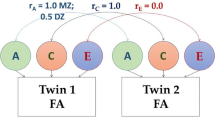Abstract
Multi-site imaging studies can increase statistical power and improve the reproducibility and generalizability of findings, yet data often need to be harmonized. One alternative to data harmonization in the normative modeling setting is Hierarchical Bayesian Regression (HBR), which overcomes some of the weaknesses of data harmonization. Here, we test the utility of three model types, i.e., linear, polynomial and b-spline - within the normative modeling HBR framework - for multi-site normative modeling of diffusion tensor imaging (DTI) metrics of the brain’s white matter microstructure, across the lifespan. These models of age dependencies were fitted to cross-sectional data from over 1,300 healthy subjects (age range: 2–80 years), scanned at eight sites in diverse geographic locations. We found that the polynomial and b-spline fits were better suited for modeling relationships of DTI metrics to age, compared to the linear fit. To illustrate the method, we also apply it to detect microstructural brain differences in carriers of rare genetic copy number variants, noting how model complexity can impact findings.
Access this chapter
Tax calculation will be finalised at checkout
Purchases are for personal use only
Similar content being viewed by others
References
Thompson, P.M., et al.: The ENIGMA Consortium: large-scale collaborative analyses of neuroimaging and genetic data. Brain Imaging Behav. 8(2), 153–182 (2014). https://doi.org/10.1007/s11682-013-9269-5
Miller, K.L., et al.: Multimodal population brain imaging in the UK Biobank prospective epidemiological study. Nat. Neurosci. 19, 1523–1536 (2016)
Van Essen, D.C., et al.: The WU-Minn human connectome project: an overview. Neuroimage 80, 62–79 (2013)
Fortin, J.-P., et al.: Harmonization of multi-site diffusion tensor imaging data. Neuroimage 161, 149–170 (2017)
Marquand, A.F., Rezek, I., Buitelaar, J., Beckmann, C.F.: Understanding heterogeneity in clinical cohorts using normative models: beyond case-control studies. Biol. Psychiatry 80, 552–561 (2016)
Kia, S.M., et al.: Hierarchical Bayesian regression for multi-site normative modeling of neuroimaging data. In: Martel, A.L., et al. (eds.) MICCAI 2020. LNCS, vol. 12267, pp. 699–709. Springer, Cham (2020). https://doi.org/10.1007/978-3-030-59728-3_68
Concha, L.: A macroscopic view of microstructure: using diffusion-weighted images to infer damage, repair, and plasticity of white matter. Neuroscience 276, 14–28 (2014)
Basser, P.J., Mattiello, J., LeBihan, D.: MR diffusion tensor spectroscopy and imaging. Biophys. J. 66, 259–267 (1994)
Landman, B.A., Farrell, J.A.D., Jones, C.K., Smith, S.A., Prince, J.L., Mori, S.: Effects of diffusion weighting schemes on the reproducibility of DTI-derived fractional anisotropy, mean diffusivity, and principal eigenvector measurements at 1.5T. NeuroImage 36, 1123–1138 (2007)
Lawrence, K.E., et al.: Advanced diffusion-weighted MRI methods demonstrate improved sensitivity to white matter aging: percentile charts for over 15,000 UK Biobank participants. Alzheimer’s Dement. 17, e051187 (2021)
Pomponio, R., Erus, G., Habes, M., Doshi, J., Srinivasan, D., Mamourian, E., et al.: Harmonization of large MRI datasets for the analysis of brain imaging patterns throughout the lifespan. Neuroimage 208, 116450 (2020)
Rutherford, S., et al.: Charting brain growth and aging at high spatial precision. eLife 11, e72904 (2022)
Jacquemont, S., et al.: Mirror extreme BMI phenotypes associated with gene dosage at the chromosome 16p11.2 locus. Nature 478, 97–102 (2011)
Walsh, K.M., Bracken, M.B.: Copy number variation in the dosage-sensitive 16p11.2 interval accounts for only a small proportion of autism incidence: a systematic review and meta-analysis. Genet. Med. 13, 377–384 (2011)
Garyfallidis, E., et al.: Dipy, a library for the analysis of diffusion MRI data. Front. Neuroinform. 8 (2014). https://pubmed.ncbi.nlm.nih.gov/24600385/
Andersson, J.L.R., Sotiropoulos, S.N.: An integrated approach to correction for off-resonance effects and subject movement in diffusion MR imaging. Neuroimage 125, 1063–1078 (2016)
Avants, B.B., Tustison, N.J., Song, G., Cook, P.A., Klein, A., Gee, J.C.: A reproducible evaluation of ANTs similarity metric performance in brain image registration. Neuroimage 54, 2033–2044 (2011)
Mori, S., et al.: Stereotaxic white matter atlas based on diffusion tensor imaging in an ICBM template. NeuroImage 40, 570–582 (2008)
Jahanshad, N., et al.: Multi-site genetic analysis of diffusion images and voxelwise heritability analysis: a pilot project of the ENIGMA–DTI working group. Neuroimage 81, 455–469 (2013)
Gillentine, M.A., Lupo, P.J., Stankiewicz, P., Schaaf, C.P.: An estimation of the prevalence of genomic disorders using chromosomal microarray data. J. Hum. Genet. 63, 795–801 (2018)
Rasmussen, C.E., Williams, C.K.I.: Gaussian Processes for Machine Learning. MIT Press, Cambridge (2006)
Wilcox, R.R.: Modern Statistics for the Social and Behavioral Sciences: A Practical Introduction. CRC Press, Boca Raton (2017)
Lebel, C., Walker, L., Leemans, A., Phillips, L., Beaulieu, C.: Microstructural maturation of the human brain from childhood to adulthood. Neuroimage 40, 1044–1055 (2008)
Acknowledgements
Canada Research Chair in Neurodevelopmental Disorders, CFREF (Institute for Data Valorization - IVADO), Brain Canada Multi-Investigator Research Initiative (MIRI). Simons Foundation Grant Nos. SFARI219193 and SFARI274424. Swiss National Science Foundation (SNSF) Marie Heim Vögtlin Grant (PMPDP3_171331). Funded in part by NIH grants U54 EB020403, T32 AG058507 and RF1AG057892.
Author information
Authors and Affiliations
Consortia
Corresponding author
Editor information
Editors and Affiliations
1 Electronic supplementary material
Below is the link to the electronic supplementary material.
Rights and permissions
Copyright information
© 2022 The Author(s), under exclusive license to Springer Nature Switzerland AG
About this paper
Cite this paper
Villalón-Reina, J.E. et al. (2022). Multi-site Normative Modeling of Diffusion Tensor Imaging Metrics Using Hierarchical Bayesian Regression. In: Wang, L., Dou, Q., Fletcher, P.T., Speidel, S., Li, S. (eds) Medical Image Computing and Computer Assisted Intervention – MICCAI 2022. MICCAI 2022. Lecture Notes in Computer Science, vol 13431. Springer, Cham. https://doi.org/10.1007/978-3-031-16431-6_20
Download citation
DOI: https://doi.org/10.1007/978-3-031-16431-6_20
Published:
Publisher Name: Springer, Cham
Print ISBN: 978-3-031-16430-9
Online ISBN: 978-3-031-16431-6
eBook Packages: Computer ScienceComputer Science (R0)





